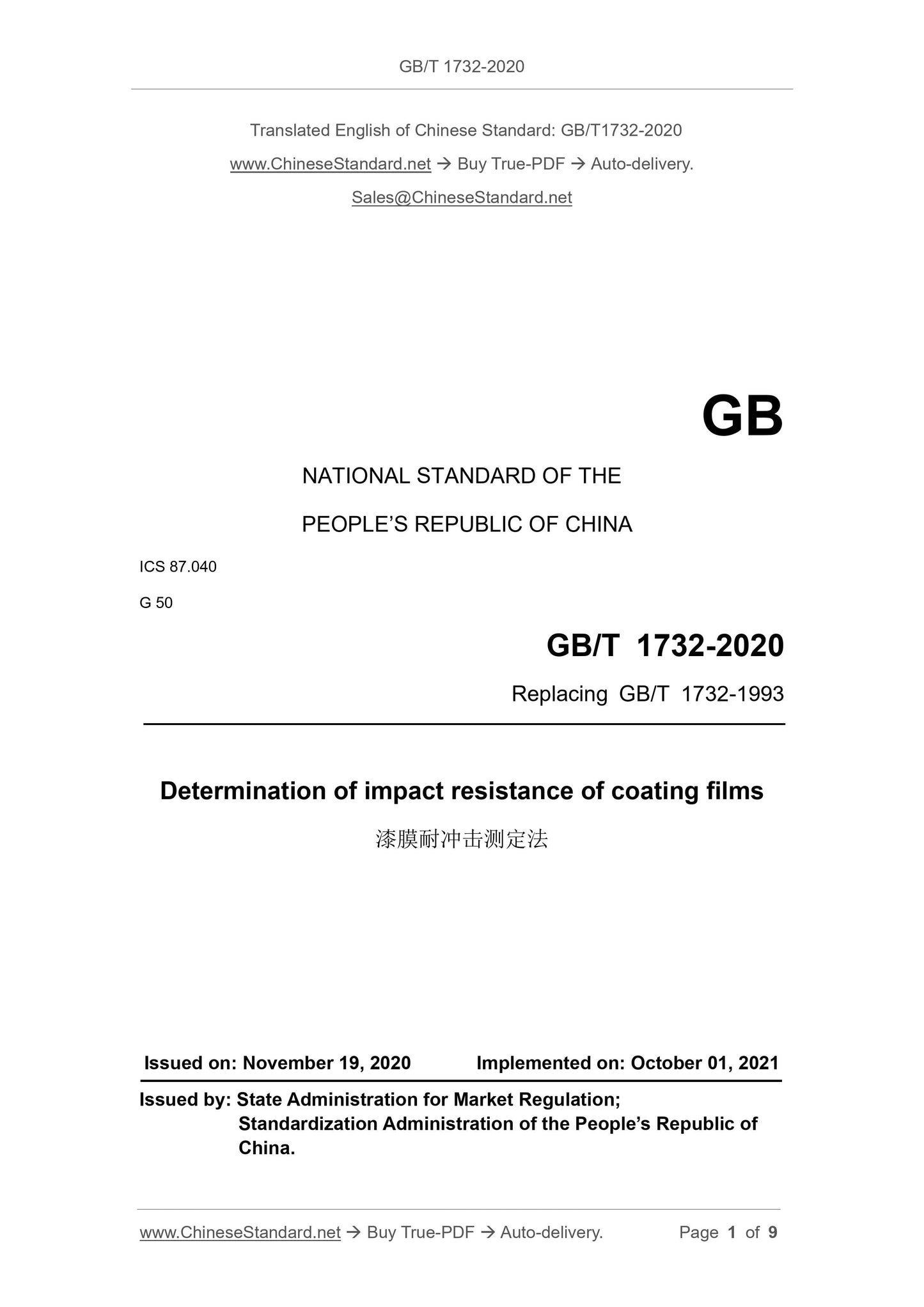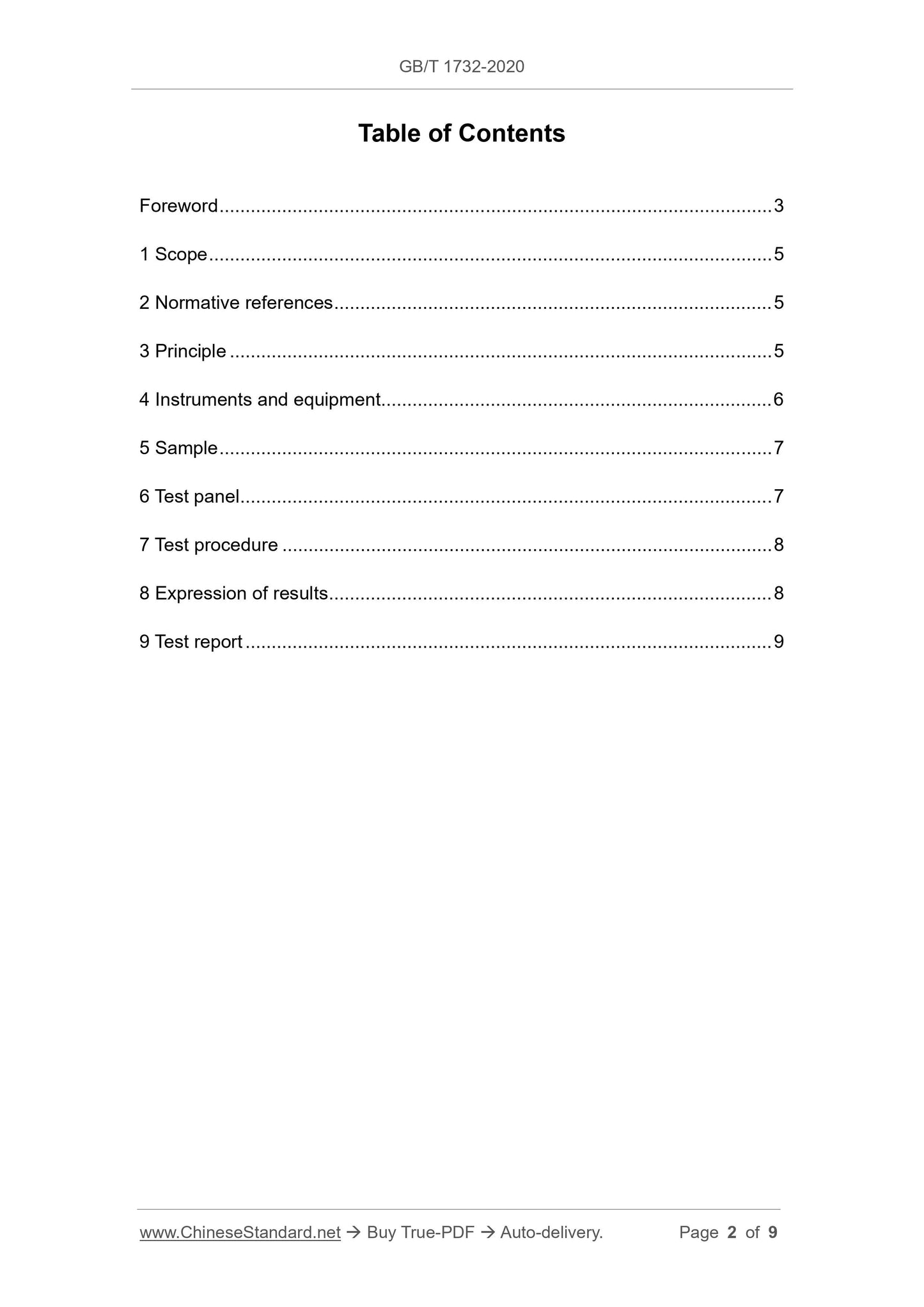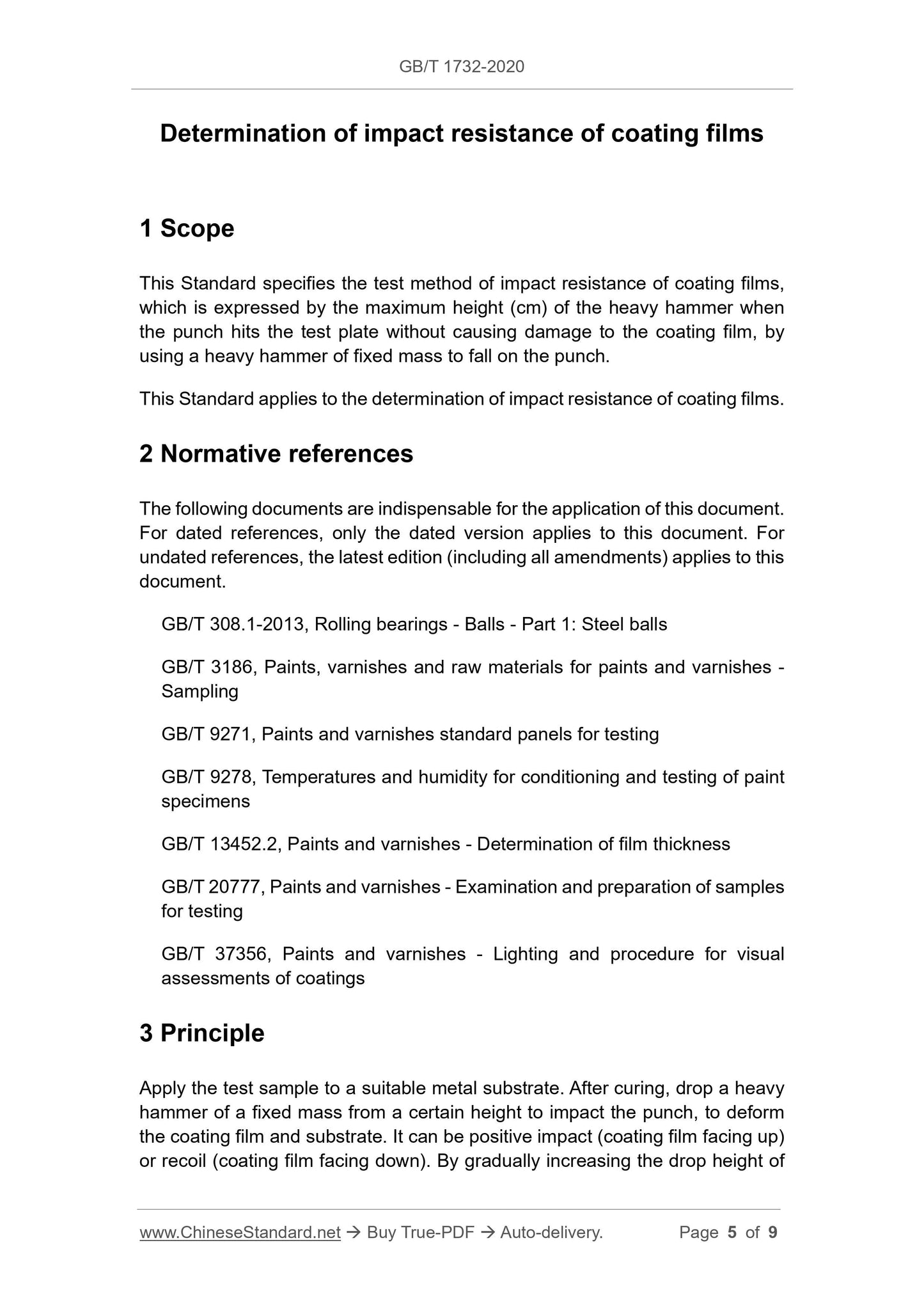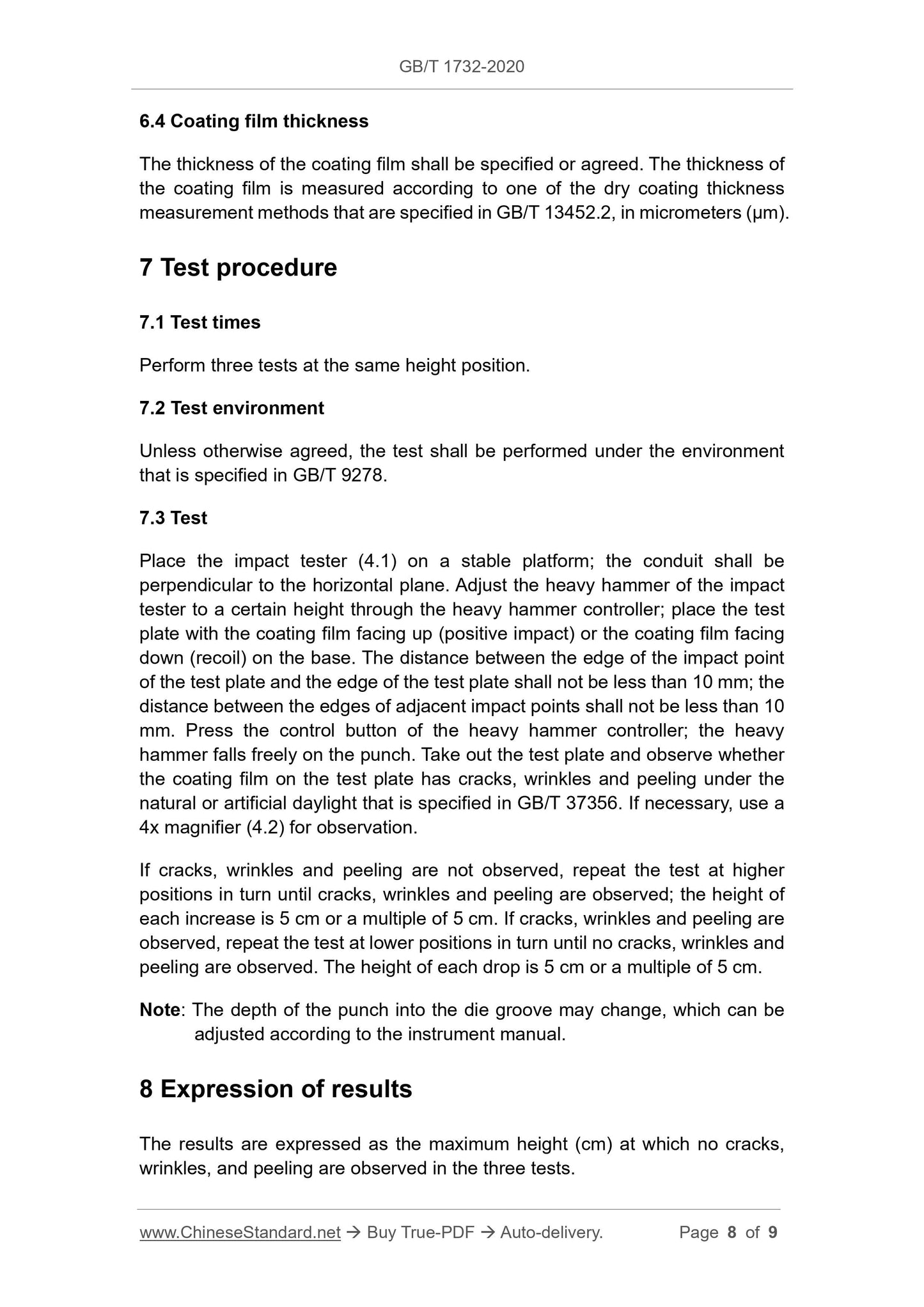1
/
of
4
www.ChineseStandard.us -- Field Test Asia Pte. Ltd.
GB/T 1732-2020 English PDF (GB/T1732-2020)
GB/T 1732-2020 English PDF (GB/T1732-2020)
Regular price
$110.00
Regular price
Sale price
$110.00
Unit price
/
per
Shipping calculated at checkout.
Couldn't load pickup availability
GB/T 1732-2020: Determination of impact resistance of coating films
Delivery: 9 seconds. Download (& Email) true-PDF + Invoice.
Get Quotation: Click GB/T 1732-2020 (Self-service in 1-minute)
Historical versions (Master-website): GB/T 1732-2020
Preview True-PDF (Reload/Scroll-down if blank)
GB/T 1732-2020
GB
NATIONAL STANDARD OF THE
PEOPLE’S REPUBLIC OF CHINA
ICS 87.040
G 50
Replacing GB/T 1732-1993
Determination of impact resistance of coating films
ISSUED ON: NOVEMBER 19, 2020
IMPLEMENTED ON: OCTOBER 01, 2021
Issued by: State Administration for Market Regulation;
Standardization Administration of the People’s Republic of
China.
Table of Contents
Foreword ... 3
1 Scope ... 5
2 Normative references ... 5
3 Principle ... 5
4 Instruments and equipment... 6
5 Sample ... 7
6 Test panel ... 7
7 Test procedure ... 8
8 Expression of results ... 8
9 Test report ... 9
Determination of impact resistance of coating films
1 Scope
This Standard specifies the test method of impact resistance of coating films,
which is expressed by the maximum height (cm) of the heavy hammer when
the punch hits the test plate without causing damage to the coating film, by
using a heavy hammer of fixed mass to fall on the punch.
This Standard applies to the determination of impact resistance of coating films.
2 Normative references
The following documents are indispensable for the application of this document.
For dated references, only the dated version applies to this document. For
undated references, the latest edition (including all amendments) applies to this
document.
GB/T 308.1-2013, Rolling bearings - Balls - Part 1: Steel balls
GB/T 3186, Paints, varnishes and raw materials for paints and varnishes -
Sampling
GB/T 9271, Paints and varnishes standard panels for testing
GB/T 9278, Temperatures and humidity for conditioning and testing of paint
specimens
GB/T 13452.2, Paints and varnishes - Determination of film thickness
GB/T 20777, Paints and varnishes - Examination and preparation of samples
for testing
GB/T 37356, Paints and varnishes - Lighting and procedure for visual
assessments of coatings
3 Principle
Apply the test sample to a suitable metal substrate. After curing, drop a heavy
hammer of a fixed mass from a certain height to impact the punch, to deform
the coating film and substrate. It can be positive impact (coating film facing up)
or recoil (coating film facing down). By gradually increasing the drop height of
6.4 Coating film thickness
The thickness of the coating film shall be specified or agreed. The thickness of
the coating film is measured according to one of the dry coating thickness
measurement methods that are specified in GB/T 13452.2, in micrometers (μm).
7 Test procedure
7.1 Test times
Perform three tests at the same height position.
7.2 Test environment
Unless otherwise agreed, the test shall be performed under the environment
that is specified in GB/T 9278.
7.3 Test
Place the impact tester (4.1) on a stable platform; the conduit shall be
perpendicular to the horizontal plane. Adjust the heavy hammer of the impact
tester to a certain height through the heavy hammer controller; place the test
plate with the coating film facing up (positive impact) or the coating film facing
down (recoil) on the base. The distance between the edge of the impact point
of the test plate and the edge of the test plate shall not be less than 10 mm; the
distance between the edges of adjacent impact points shall not be less than 10
mm. Press the control button of the heavy hammer controller; the heavy
hammer falls freely on the punch. Take out the test plate and observe whether
the coating film on the test plate has cracks, wrinkles and peeling under the
natural or artificial daylight that is specified in GB/T 37356. If necessary, use a
4x magnifier (4.2) for observation.
If cracks, wrinkles and peeling are not observed, repeat the test at higher
positions in turn until cracks, wrinkles and peeling are observed; the height of
each increase is 5 cm or a multiple of 5 cm. If cracks, wrinkles and peeling are
observed, repeat the test at lower positions in turn until no cracks, wrinkles and
peeling are observed. The height of each drop is 5 cm or a multiple of 5 cm.
Note: The depth of the punch into the die groove may change, which can be
adjusted according to the instrument manual.
8 Expression of results
The results are expressed as the maximum height (cm) at which no cracks,
wrinkles, and peeling are observed in the three tests.
GB/T 1732-2020
GB
NATIONAL STANDARD OF THE
PEOPLE’S REPUBLIC OF CHINA
ICS 87.040
G 50
Replacing GB/T 1732-1993
Determination of impact resistance of coating films
ISSUED ON: NOVEMBER 19, 2020
IMPLEMENTED ON: OCTOBER 01, 2021
Issued by: State Administration for Market Regulation;
Standardization Administration of the People’s Republic of
China.
Table of Contents
Foreword ... 3
1 Scope ... 5
2 Normative references ... 5
3 Principle ... 5
4 Instruments and equipment... 6
5 Sample ... 7
6 Test panel ... 7
7 Test procedure ... 8
8 Expression of results ... 8
9 Test report ... 9
Determination of impact resistance of coating films
1 Scope
This Standard specifies the test method of impact resistance of coating films,
which is expressed by the maximum height (cm) of the heavy hammer when
the punch hits the test plate without causing damage to the coating film, by
using a heavy hammer of fixed mass to fall on the punch.
This Standard applies to the determination of impact resistance of coating films.
2 Normative references
The following documents are indispensable for the application of this document.
For dated references, only the dated version applies to this document. For
undated references, the latest edition (including all amendments) applies to this
document.
GB/T 308.1-2013, Rolling bearings - Balls - Part 1: Steel balls
GB/T 3186, Paints, varnishes and raw materials for paints and varnishes -
Sampling
GB/T 9271, Paints and varnishes standard panels for testing
GB/T 9278, Temperatures and humidity for conditioning and testing of paint
specimens
GB/T 13452.2, Paints and varnishes - Determination of film thickness
GB/T 20777, Paints and varnishes - Examination and preparation of samples
for testing
GB/T 37356, Paints and varnishes - Lighting and procedure for visual
assessments of coatings
3 Principle
Apply the test sample to a suitable metal substrate. After curing, drop a heavy
hammer of a fixed mass from a certain height to impact the punch, to deform
the coating film and substrate. It can be positive impact (coating film facing up)
or recoil (coating film facing down). By gradually increasing the drop height of
6.4 Coating film thickness
The thickness of the coating film shall be specified or agreed. The thickness of
the coating film is measured according to one of the dry coating thickness
measurement methods that are specified in GB/T 13452.2, in micrometers (μm).
7 Test procedure
7.1 Test times
Perform three tests at the same height position.
7.2 Test environment
Unless otherwise agreed, the test shall be performed under the environment
that is specified in GB/T 9278.
7.3 Test
Place the impact tester (4.1) on a stable platform; the conduit shall be
perpendicular to the horizontal plane. Adjust the heavy hammer of the impact
tester to a certain height through the heavy hammer controller; place the test
plate with the coating film facing up (positive impact) or the coating film facing
down (recoil) on the base. The distance between the edge of the impact point
of the test plate and the edge of the test plate shall not be less than 10 mm; the
distance between the edges of adjacent impact points shall not be less than 10
mm. Press the control button of the heavy hammer controller; the heavy
hammer falls freely on the punch. Take out the test plate and observe whether
the coating film on the test plate has cracks, wrinkles and peeling under the
natural or artificial daylight that is specified in GB/T 37356. If necessary, use a
4x magnifier (4.2) for observation.
If cracks, wrinkles and peeling are not observed, repeat the test at higher
positions in turn until cracks, wrinkles and peeling are observed; the height of
each increase is 5 cm or a multiple of 5 cm. If cracks, wrinkles and peeling are
observed, repeat the test at lower positions in turn until no cracks, wrinkles and
peeling are observed. The height of each drop is 5 cm or a multiple of 5 cm.
Note: The depth of the punch into the die groove may change, which can be
adjusted according to the instrument manual.
8 Expression of results
The results are expressed as the maximum height (cm) at which no cracks,
wrinkles, and peeling are observed in the three tests.
Delivery: 9 seconds. Download (& Email) true-PDF + Invoice.
Get Quotation: Click GB/T 1732-2020 (Self-service in 1-minute)
Historical versions (Master-website): GB/T 1732-2020
Preview True-PDF (Reload/Scroll-down if blank)
GB/T 1732-2020
GB
NATIONAL STANDARD OF THE
PEOPLE’S REPUBLIC OF CHINA
ICS 87.040
G 50
Replacing GB/T 1732-1993
Determination of impact resistance of coating films
ISSUED ON: NOVEMBER 19, 2020
IMPLEMENTED ON: OCTOBER 01, 2021
Issued by: State Administration for Market Regulation;
Standardization Administration of the People’s Republic of
China.
Table of Contents
Foreword ... 3
1 Scope ... 5
2 Normative references ... 5
3 Principle ... 5
4 Instruments and equipment... 6
5 Sample ... 7
6 Test panel ... 7
7 Test procedure ... 8
8 Expression of results ... 8
9 Test report ... 9
Determination of impact resistance of coating films
1 Scope
This Standard specifies the test method of impact resistance of coating films,
which is expressed by the maximum height (cm) of the heavy hammer when
the punch hits the test plate without causing damage to the coating film, by
using a heavy hammer of fixed mass to fall on the punch.
This Standard applies to the determination of impact resistance of coating films.
2 Normative references
The following documents are indispensable for the application of this document.
For dated references, only the dated version applies to this document. For
undated references, the latest edition (including all amendments) applies to this
document.
GB/T 308.1-2013, Rolling bearings - Balls - Part 1: Steel balls
GB/T 3186, Paints, varnishes and raw materials for paints and varnishes -
Sampling
GB/T 9271, Paints and varnishes standard panels for testing
GB/T 9278, Temperatures and humidity for conditioning and testing of paint
specimens
GB/T 13452.2, Paints and varnishes - Determination of film thickness
GB/T 20777, Paints and varnishes - Examination and preparation of samples
for testing
GB/T 37356, Paints and varnishes - Lighting and procedure for visual
assessments of coatings
3 Principle
Apply the test sample to a suitable metal substrate. After curing, drop a heavy
hammer of a fixed mass from a certain height to impact the punch, to deform
the coating film and substrate. It can be positive impact (coating film facing up)
or recoil (coating film facing down). By gradually increasing the drop height of
6.4 Coating film thickness
The thickness of the coating film shall be specified or agreed. The thickness of
the coating film is measured according to one of the dry coating thickness
measurement methods that are specified in GB/T 13452.2, in micrometers (μm).
7 Test procedure
7.1 Test times
Perform three tests at the same height position.
7.2 Test environment
Unless otherwise agreed, the test shall be performed under the environment
that is specified in GB/T 9278.
7.3 Test
Place the impact tester (4.1) on a stable platform; the conduit shall be
perpendicular to the horizontal plane. Adjust the heavy hammer of the impact
tester to a certain height through the heavy hammer controller; place the test
plate with the coating film facing up (positive impact) or the coating film facing
down (recoil) on the base. The distance between the edge of the impact point
of the test plate and the edge of the test plate shall not be less than 10 mm; the
distance between the edges of adjacent impact points shall not be less than 10
mm. Press the control button of the heavy hammer controller; the heavy
hammer falls freely on the punch. Take out the test plate and observe whether
the coating film on the test plate has cracks, wrinkles and peeling under the
natural or artificial daylight that is specified in GB/T 37356. If necessary, use a
4x magnifier (4.2) for observation.
If cracks, wrinkles and peeling are not observed, repeat the test at higher
positions in turn until cracks, wrinkles and peeling are observed; the height of
each increase is 5 cm or a multiple of 5 cm. If cracks, wrinkles and peeling are
observed, repeat the test at lower positions in turn until no cracks, wrinkles and
peeling are observed. The height of each drop is 5 cm or a multiple of 5 cm.
Note: The depth of the punch into the die groove may change, which can be
adjusted according to the instrument manual.
8 Expression of results
The results are expressed as the maximum height (cm) at which no cracks,
wrinkles, and peeling are observed in the three tests.
GB/T 1732-2020
GB
NATIONAL STANDARD OF THE
PEOPLE’S REPUBLIC OF CHINA
ICS 87.040
G 50
Replacing GB/T 1732-1993
Determination of impact resistance of coating films
ISSUED ON: NOVEMBER 19, 2020
IMPLEMENTED ON: OCTOBER 01, 2021
Issued by: State Administration for Market Regulation;
Standardization Administration of the People’s Republic of
China.
Table of Contents
Foreword ... 3
1 Scope ... 5
2 Normative references ... 5
3 Principle ... 5
4 Instruments and equipment... 6
5 Sample ... 7
6 Test panel ... 7
7 Test procedure ... 8
8 Expression of results ... 8
9 Test report ... 9
Determination of impact resistance of coating films
1 Scope
This Standard specifies the test method of impact resistance of coating films,
which is expressed by the maximum height (cm) of the heavy hammer when
the punch hits the test plate without causing damage to the coating film, by
using a heavy hammer of fixed mass to fall on the punch.
This Standard applies to the determination of impact resistance of coating films.
2 Normative references
The following documents are indispensable for the application of this document.
For dated references, only the dated version applies to this document. For
undated references, the latest edition (including all amendments) applies to this
document.
GB/T 308.1-2013, Rolling bearings - Balls - Part 1: Steel balls
GB/T 3186, Paints, varnishes and raw materials for paints and varnishes -
Sampling
GB/T 9271, Paints and varnishes standard panels for testing
GB/T 9278, Temperatures and humidity for conditioning and testing of paint
specimens
GB/T 13452.2, Paints and varnishes - Determination of film thickness
GB/T 20777, Paints and varnishes - Examination and preparation of samples
for testing
GB/T 37356, Paints and varnishes - Lighting and procedure for visual
assessments of coatings
3 Principle
Apply the test sample to a suitable metal substrate. After curing, drop a heavy
hammer of a fixed mass from a certain height to impact the punch, to deform
the coating film and substrate. It can be positive impact (coating film facing up)
or recoil (coating film facing down). By gradually increasing the drop height of
6.4 Coating film thickness
The thickness of the coating film shall be specified or agreed. The thickness of
the coating film is measured according to one of the dry coating thickness
measurement methods that are specified in GB/T 13452.2, in micrometers (μm).
7 Test procedure
7.1 Test times
Perform three tests at the same height position.
7.2 Test environment
Unless otherwise agreed, the test shall be performed under the environment
that is specified in GB/T 9278.
7.3 Test
Place the impact tester (4.1) on a stable platform; the conduit shall be
perpendicular to the horizontal plane. Adjust the heavy hammer of the impact
tester to a certain height through the heavy hammer controller; place the test
plate with the coating film facing up (positive impact) or the coating film facing
down (recoil) on the base. The distance between the edge of the impact point
of the test plate and the edge of the test plate shall not be less than 10 mm; the
distance between the edges of adjacent impact points shall not be less than 10
mm. Press the control button of the heavy hammer controller; the heavy
hammer falls freely on the punch. Take out the test plate and observe whether
the coating film on the test plate has cracks, wrinkles and peeling under the
natural or artificial daylight that is specified in GB/T 37356. If necessary, use a
4x magnifier (4.2) for observation.
If cracks, wrinkles and peeling are not observed, repeat the test at higher
positions in turn until cracks, wrinkles and peeling are observed; the height of
each increase is 5 cm or a multiple of 5 cm. If cracks, wrinkles and peeling are
observed, repeat the test at lower positions in turn until no cracks, wrinkles and
peeling are observed. The height of each drop is 5 cm or a multiple of 5 cm.
Note: The depth of the punch into the die groove may change, which can be
adjusted according to the instrument manual.
8 Expression of results
The results are expressed as the maximum height (cm) at which no cracks,
wrinkles, and peeling are observed in the three tests.
Share







